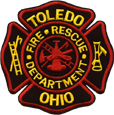EMERGENCY ASSISTANCE IS NOT AVAILABLE THROUGH THIS WEB SITE
In an emergency within the City of Toledo, or Lucas County, call 911 or your local emergency number immediately from any wired or wireless phone.
An emergency is any situation that requires immediate assistance from the Toledo Fire & Rescue Department, or Toledo Police.
Call 911 if:
- There is a fire
- Motor vehicle accident with injuries
- A victim with a life or limb threatening condition/injury
- The person’s condition is life-threatening (for example, heart attack, or allergic reaction)
- The person’s condition could become life-threatening on the way to the hospital
- Moving the person could cause further injury ( for example, a neck/back injury )
- A victim needing the skills and/or equipment of E.M.T.’s or Paramedics
- A medical emergency, such as someone who is unconscious, gasping for air or not breathing, experiencing an allergic reaction, having chest pain, having uncontrollable bleeding, or any other symptoms that require immediate medical attention
- Traffic conditions or distance might cause a delay in getting the person to the hospital
Important: If you’re not sure whether the situation is a true emergency, don’t guess, call 911.
Other examples of warning signs of medical emergencies:
- Bleeding that will not stop
- Breathing problems, difficulty in breathing, or shortness of breath
- Change in mental status, such as unusual behavior, confusion, or difficulty arousing
- Chest pain
- Coughing up or vomiting blood
- Fainting or loss of consciousness
- Feeling of committing suicide or murder
- Head or spine injury
- Severe or persistent vomiting
- Sudden injury due to motor vehicle accident, burns or smoke inhalation
- Near drowning, deep or large wound
- Sudden, severe pain anywhere in the body
- Sudden dizziness, weakness, or change in vision
- Swallowing a poisonous substance
- Upper abdominal pain or pressure
When you call 911, be prepared to answer the call-taker’s questions, which may include:
- The location of the emergency, including the street address
- The phone number you are calling from
- The nature of the emergency
- Details about the emergency, such as a physical description of a person who may have committed a crime, a description of any fire that may be burning, or a description of injuries or symptoms being experienced by a person having a medical emergency
- Remember, the call-taker’s questions are important to get the right kind of help to you quickly.
Examples of NON-EMERGENCY situations include:
- Minor injury or illness not requiring immediate help
- Chronic aches and pains (lasting for a long period of time and/or recurring)
- Minor cuts
Finally, do not hang up until the call-taker instructs you to do so. You may be given instructions to tell you exactly what to do to help in an emergency until help arrives, such as providing step-by-step instructions to aid someone who is choking or needs first aid or CPR.
While waiting for help to arrive, if given specific instructions, carry them out. Do not move someone who is injured unless they are in danger. Make it easy for us to find you, send someone to meet us or turn on porch lights. Other things that you can do: place pets in a room away from rescuers, gather medical information, give easy access to patient-clear a route, if possible.
If you dial 911 by mistake, or if a child in your home dials 911 when no emergency exists, do not hang up—that could make 911 officials think that an emergency exists, and possibly send responders to your location. Instead, simply explain to the call-taker what happened.
